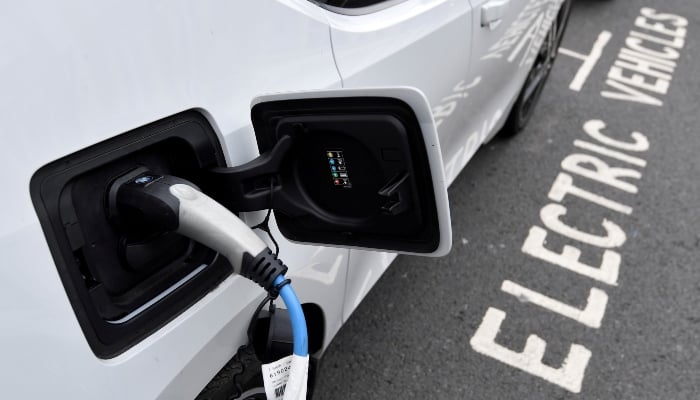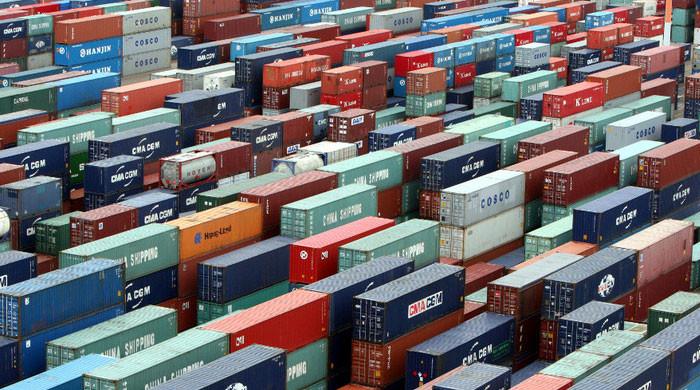Powering Pakistan's EV revolution
Pakistan targets 30% EV penetration by 2030, potentially saving over $800m annually
February 07, 2025

Transitioning to climate-friendly electric vehicles (EVs) is crucial for Pakistan to reduce greenhouse gas emissions and achieve sustainability. With a projected population of over 400 million and 70% urbanisation in the next 25 years, the shift from internal combustion engine (ICE) vehicles to EVs is critical to mitigating environmental and socio-economic risks.
EV adoption is vital for economic and environmental sustainability, aligning with global decarbonisation efforts and the Paris Agreement. Pakistan targets 30% EV penetration by 2030, potentially saving over $800 million annually and significantly reducing emissions by transitioning public transport from polluting ICE vehicles to EVs.
A structured approach addressing financial, regulatory, and infrastructure challenges is essential. The New Energy Vehicles Policy (2025-2030), currently under development, requires a coordinated multi-stakeholder effort, as demonstrated in a recent Sustainable Development Policy Institute (SDPI) forum, where policymakers, banks, academia, and industry experts discussed solutions.
One of the main hurdles to EV adoption is the high upfront cost, with batteries constituting 40-50% of an EV’s total price. Despite lithium prices declining by 60% in 2023, affordability remains a challenge. The lack of infrastructure is another major barrier, as Pakistan’s charging network remains sparse. Public-private partnerships could provide a viable solution to accelerate expansion. Limited battery warranties and shorter lifespans also pose a risk for consumers, which can be mitigated through warranty-backed financing solutions.
Another significant concern is the uncertainty surrounding EV resale value due to the absence of historical data, making it difficult for lenders to assess risk. Establishing a robust secondary market for EVs could address this issue. The outdated national grid also poses challenges, necessitating urgent upgrades by the National Transmission and Despatch Company to support EV integration effectively.
The unreliable electricity supply exacerbates range anxiety among potential EV users, emphasising the need for integrating renewable energy sources into EV charging stations. High interest rates make financing difficult, necessitating greater subsidies to facilitate the transition from ICE-powered vehicles. Concessional financing from multilateral and domestic development banks is crucial to support EV infrastructure on a public-private partnership basis. The lack of government incentives, policies and subsidies remains a major barrier, requiring comprehensive measures to encourage adoption.
Several developing countries offer valuable lessons on EV financing. Kenya has focused on electric motorcycles to meet rural mobility needs, providing affordable financing options to users. Vietnam has successfully leveraged public-private partnerships to expand EV infrastructure while balancing risks between the government and private investors. These examples highlight scalable, innovative approaches that Pakistan can adapt to its unique context.
China serves as a significant case study in EV ecosystem development. The Chinese government has invested $230 billion from 2009 to 2023 through rebates, sales tax exemptions and infrastructure investments, fostering rapid EV adoption. Pakistan can implement a similar phased and time-bound approach to incentivise the private sector. China’s technological leadership, particularly in lithium battery production, has been a key factor in making EVs more affordable.
With Western markets imposing high tariffs on Chinese manufacturers, companies such as BYD and Geely Farizon are increasingly targeting smaller, trade-friendly nations. This presents an opportunity for Pakistan to capitalise on its free trade agreements with China. Both BYD and Geely Farizon have already partnered with large Pakistani corporations to introduce four-wheel and commercial-use EVs in 2025, with plans for localisation to encourage the development of the vendor sector over the next few years. Collaboration with Chinese manufacturers could help Pakistan gain technical expertise, promote entrepreneurship in allied sectors and create domestic jobs.
India’s journey toward EV adoption provides another regional model. In addition to direct government incentives, Indian financial institutions and regulators have played a critical role in accelerating the transition. The National Electric Mobility Mission Plan 2020 was launched to improve fuel security and transition the country toward EVs, setting a goal of 30% of new road mobility to be EV-based by 2030. The Faster Adoption and Manufacturing of Hybrid and Electric Vehicles (FAME) initiative has been instrumental in ensuring collaboration between public and private sector banks, which have worked alongside the government to direct funds to intended beneficiaries.
The Indian Energy Efficiency Services Limited (EESL), a government entity like Pakistan’s National Energy Efficiency & Conservation Agency (NEECA), secured funding from the World Bank and the Asian Development Bank to install public charging stations across urban areas, highlighting the effectiveness of public-private partnership models.
To further support EV adoption, Indian banks have introduced tailored financing solutions to make EV ownership more affordable. The State Bank of India (SBI) launched the Green Car Loan scheme, offering lower interest rates and longer repayment periods for EV buyers. Private sector commercial banks such as ICICI Bank and Axis Bank provide easy financing for both individual EV owners and fleet operators, offering flexible payment terms aligned with EV lifecycle costs.
The Reserve Bank of India (RBI) has included EV financing under priority sector lending, introducing SIDBI, a credit guarantee scheme for loans to clean energy startups and EV companies. Once the activity base for EVs expanded, Indian financial markets leveraged the issuance of ‘green bonds’ to mobilise capital for clean energy projects, including EV manufacturing and infrastructure. YES Bank issued India’s first green bond, raising INR 10 billion for sustainable transport initiatives. Such debt instruments have provided low-cost capital for EV manufacturers and infrastructure developers, enabling secondary market trading once credit-rated and listed on exchanges.
Adopting a similar ‘consult-collaborate-cocreate’ approach could create synergy among stakeholders in Pakistan and develop sustainable value chains that generate employment while reducing environmental impact. Offering time-restricted incentives and setting minimum content requirements linked to tax holidays for manufacturers will encourage participation. However, to ensure sector growth is effectively stewarded, the government must implement clear regulatory measures and penalties.
The development of a climate-friendly mobility ecosystem in Pakistan aligns with several United Nations Sustainable Development Goals (SDGs). Expanding EV charging and swappable battery infrastructure powered by renewable energy sources supports SDG 7 on affordable and clean energy. Promoting innovation in the automotive sector and building robust transportation infrastructure aligns with SDG 9, which focuses on industry, innovation, and infrastructure. Encouraging low-emission transportation solutions contributes to SDG 11, which emphasises sustainable cities and communities. Reducing carbon emissions through cleaner transportation options directly supports SDG 13 on climate action.
Creating employment opportunities through local EV manufacturing and associated industries aligns with SDG 8, which promotes decent work and economic growth. All these aspects can potentially get projects accredited for carbon credits with international registries such as Verra and Gold Standard, and also create buoyancy for Pakistan’s carbon markets.
Transitioning Pakistan toward a climate-friendly mobility ecosystem presents both challenges and opportunities. By addressing financing barriers, learning from successful regional models, and implementing targeted policies, Pakistan can lay the groundwork for a sustainable future. With a strategic focus on public-private collaboration, infrastructure development, and incentivised financing, the country can achieve its environmental goals while advancing economic growth.
The writer is a seasoned banker with 30 years of international expertise in global markets and development finance. He can be reached at:[email protected].
Disclaimer: The viewpoints expressed in this piece are the writer's own and don't necessarily reflect Geo.tv's editorial policy.
Originally published in The News











